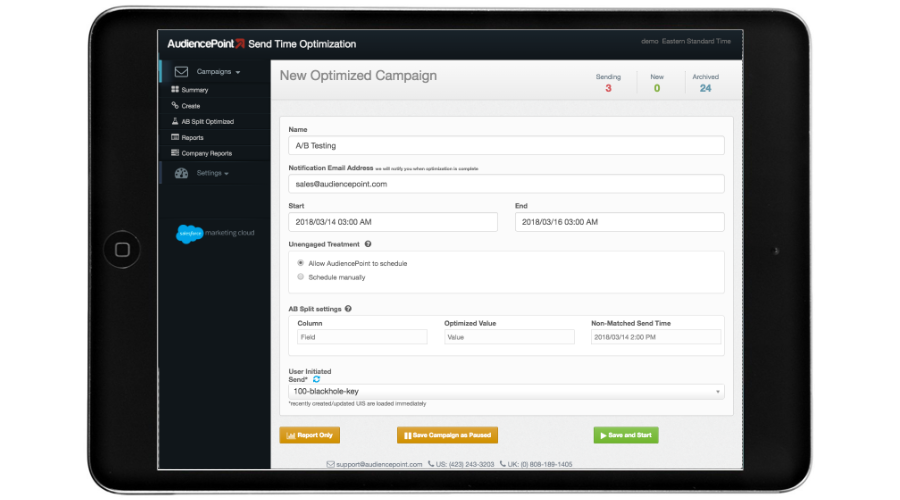AudiencePoint is thrilled to announce our new integration with Klaviyo! AudiencePoint is looking for partners to pilot our...
Your marketing emails can’t be successful if they don’t even land in your subscribers’ inboxes in the first place. That’s why email marketers measure email deliverability rates to ensure their messages aren’t bouncing, landing in spam folders, or showing other negative signs that could harm your engagement over the long term.
If you’re wondering how to check email deliverability, you’re in the right place. We’ll break everything down from what deliverability is, how to check it, and how to improve your deliverability rates for increased email marketing success. Keep reading to get all the details.
What Is Email Deliverability?
Email deliverability is a measurement of the ability to deliver emails to subscribers’ inboxes. Every time your emails bounce or land in spam folders, it will negatively impact your deliverability rates.
Poor deliverability can also have a compounding effect since the more often your emails aren’t accepted, the more it triggers spam detectors from email service providers. When left unaddressed, you can see your engagement continue to drop to a point that’s hard to recover from.
If you’re struggling with deliverability rates or simply want to put preventative measures in place, insight software like AudiencePoint can help. AudiencePoint works by analyzing your email metrics and subscriber activity to provide you with actionable insights that you can easily implement into your campaigns. It’ll even help you catch deliverability concerns early on before they become an issue.
What Affects Email Deliverability?
As mentioned, email bounces and landing in spam folders are big factors that affect deliverability. However, those aren’t the only factors that will have an impact. Some other aspects that affect deliverability are:
- Engagement rates: Your overall engagement rates on content can affect deliverability. For instance, if you have consistently low open rates when excluding Apple MPP opens, email service providers may begin to detect your messages as spam, lowering your ability to get emails in subscriber inboxes successfully.
- IP reputation: Your IP reputation is what internet service providers (ISPs) use to measure a sender’s spamminess. If ISPs are ranking your reputation too low, there’s a better chance you’ll land in spam folders or have your emails bounce.
- Email list quality: Having a quality email list full of verified recipients that are highly engaged is an important factor. It’s beneficial to scrub your list regularly using tools like AudiencePoint’s email insight software to identify subscribers who need to be re-engaged and suppress any dormant emails that can hurt your deliverability.
- Email timing: An aspect that can be overlooked is the time you send content. If you’re consistently sending emails at times when subscribers don’t engage, it will hurt your deliverability over time. You can use tools like AudiencePoint’s Send Time Optimization to help easily improve the days and times you choose to send content.
- Email volume: The frequency of your emails can also impact deliverability rates. Sending too many emails too frequently can indicate spamminess, lowering engagement rates and hurting your deliverability. Also, sending content irregularly or not frequently enough can also hurt engagement, so a good balance is necessary here.
As you can see, there are numerous aspects that can affect your deliverability. Managing and tracking data for each one can be hard to do on your own or impossible for large companies with a lot to manage. That’s why insight software like AudiencePoint, which helps manage the health of your email list, is a must to see the best chances of success.
How to Check Email Deliverability
Many email marketers who learn about the impacts of deliverability will wonder if there’s some kind of email deliverability test or way to find out their specific metrics to optimize for success.
While there are things like free email deliverability tests that can give a rough estimate, they aren’t necessarily the most accurate way to ensure the deliverability of your content.
Some great steps to test for deliverability before sending are:
- Authentication testing: Before sending content, check to make sure you’ve set up your DKIM, SPF, DMARK, and BIMI records correctly. These records help verify your domain to ISPs to increase your IP reputation scores.
- Test your content: It can be a good idea to send test emails to a controlled account before sending out an email blast to subscribers. Check to ensure the content displays well on mobile, images load well, and clickable elements are all activated properly.
- Seed list testing: You can use email deliverability tools to do seed list testing, which helps provide an unbiased opinion of how your emails will perform when sent to different ISPs, browsers, and devices. It can help show the weaknesses in your content or email-sending practices to improve deliverability. Sead lists can only truely tell you the results for those specific addresses. So while they’re somewhat helpful they are limited in their scope.
- Inbox Signal Score: At AudiencePoint, we have also developed a method of Inbox Signal Scoring. We are able to leverage Apple MPP data to determine if your mail is being delivered into the spam folder. While only a portion of your list will have Apple MPP enabled this provides a much larger sample as compared to sead lists.
Doing these checks and maintaining good overall email list hygiene using best practices like re-engaging inactive subscribers, optimizing send times, and using a double opt-in on signup can all make a big difference in email deliverability.
How Do You Measure Email Deliverability?
Ideally, the overall measurement of email deliverability rate is calculated by dividing the number of delivered emails (ones that landed in subscriber inboxes) by the total number of emails sent.
Some email marketing tools may also give you an email deliverability score to try to estimate how likely it is that your emails land in inboxes before you send them. Those scores will typically take into account aspects like your estimated IP reputation and previous deliverability rates from past content.
However, it’s important to remember that’s just an estimate and won’t necessarily result in your actual deliverability once you send content.
What Is the Common Reason for Bad Deliverability?
The most common cause of bad deliverability can surprise some email marketers. It’s sending content after taking a long break from emailing subscribers. Typically, this is somewhere between 3-6 months of not sending any content.
This can raise suspicion from ISPs, often due to the fact that someone could have sold the account and email list or that email accounts and lists left unattended can be more vulnerable to breaches.
Therefore, it is important to continue sending regular content over the long term. It’s often a good idea to send emails once a week to keep subscribers continuously engaged with your content. Just avoid sending numerous times per day, which can come across as spammy to ISPs.
Additionally, you should also ensure you keep up on other best practices like list hygiene and maintaining high engagement rates that were mentioned earlier that contribute significantly to deliverability.
Which Strategy Will Improve Email Deliverability?
Now you’re probably wondering about the best email deliverability strategies to improve it. As mentioned, a great way to improve deliverability is by using proper email list hygiene. Insight software like AudiencePoint will help immensely in that process.
AudiencePoint can help track subscriber activity and engagement on your content. You’ll get insights on when subscribers are most likely to engage, subscribers who need to be re-engaged, and dormant emails that should be suppressed from sending. Taking these measures will not only improve deliverability but also prevent significant drops in the future. AudiencePoint can also use Apple MPP to give you much more direct insight to your actual deliverability than any other solution.
You should also use best practices in building your email list. Try to use double opt-ins and use email verification tools before adding anyone to your list. This ensures that the subscribers you add are really interested in receiving content from you, making them more likely to engage.
Additionally, sending high-quality content that subscribers find value in is very important. You should be tracking to see which types of content get the most engagement and find ways to improve your metrics, like improving subject lines to boost your open rates or using impactful calls to action to boost click-through rates.
What Are Email Deliverability Tools?
Email deliverability tools are commonly used by companies with large email lists that are looking to optimize the deliverability of their content. Oftentimes, bulk email sends can cause email deliverability problems due to server issues or ISPs detecting a high volume of emails sent from a single domain as spam.
Many companies in this position will turn to tools like GreenArrow that can help immensely in improving the deliverability of their bulk emails quickly and easily.
Other deliverability tools also exist that will provide distinct deliverability metrics that help you optimize content for success.
If you’re looking for tools that can help you improve email engagement and deliverability, AudiencePoint has many great options that can help.
How AudiencePoint Can Help
AudiencePoint offers email insight software with three easy-to-implement tools that will make your email campaigns more successful. The tools offered through AudiencePoint are: Send Time Optimization, Real Time Optimization, and ListFit.
With AudiencePoint, you’ll get insights about subscriber activity and adjustments you can make to your email strategy from the moment you hit send on a new campaign. This is an excellent feature for anyone in a fast-paced business environment where decisions must be made quickly.
Additionally, you can rest assured you’re getting insight software that uses email marketing best practices that stand out amongst the competition. AudiencePoint implements approaches like identifying Apple MPP opens and isolating them from reporting since they can inflate open rate metrics, in addition to using second-party data to make the insights more accurate.
If AudiencePoint sounds like it would be right for you, contact us today to learn more about getting started!




